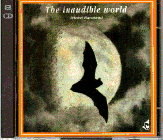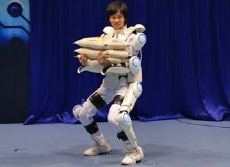Technology
Kiddie Treadmills
Those tykes today! if they're not wearing Baby High Heels, they're improving their lung capacity like little Wall Street "Masters of the Universe" on special kiddie treadmills. Read all about the craze here.
Posted By: Paul - Thu Sep 18, 2008 -
Comments (16)
Category: Business, Products, Exercise and Fitness, Fads, Family, Children, Parents, Frauds, Cons and Scams, Technology
Follies of the Mad Men #27
[Frpm Life magazine for June 9 1952. Two separate scans, upper and lower.]
James Brown's got nothing on this guy!
Posted By: Paul - Wed Sep 17, 2008 -
Comments (13)
Category: Business, Advertising, Domestic, Marriage, Family, Children, Husbands, Parents, Wives, Pets, Dogs, Technology, Gender, 1950s
Swedish Bat Detectors
 I'd call this weird in the sense of out-of-the-ordinary and interesting. I certainly wasn't aware that there were gadgets specifically for listening to bats. From the site:
I'd call this weird in the sense of out-of-the-ordinary and interesting. I certainly wasn't aware that there were gadgets specifically for listening to bats. From the site: And if you'd like some music to relax to, try The Inaudible World, a collection of bat sounds put together by Michel Barataud. I'm wondering if you need the bat detector to hear the "inaudible" CD.
And if you'd like some music to relax to, try The Inaudible World, a collection of bat sounds put together by Michel Barataud. I'm wondering if you need the bat detector to hear the "inaudible" CD.
Posted By: Alex - Fri Sep 12, 2008 -
Comments (2)
Category: Animals, Technology
Robot Suit Enters Production

This unique method of operation means that a person can control Robot Suit HAL by his or her own will, even if he or she is unable to actually move. And as the suit detects the signal sent from the brain even before it gets to the muscle, it can move an instant before the muscle does.
a) They chose to name it Robot Suit HAL (as in HAL, from 2001: A Space Odyssey).
b) They chose to name their company Cyberdyne, Inc. (as in Cyberdyne from the Terminator movies.)
So I'm going to need a little more evidence before I'm convinced this isn't a joke.
Posted By: Alex - Wed Sep 10, 2008 -
Comments (3)
Category: Inventions, Technology
Follies of the Mad Men #25

Let's watch A TOUCH OF MAGIC.
Posted By: Paul - Mon Sep 08, 2008 -
Comments (8)
Category: Business, Advertising, Products, Domestic, Marriage, Family, Husbands, Wives, Food, Futurism, History, Inventions, Movies, Pop Culture, Technology, Sex Symbols, 1960s, Dance, Cars, Yesterday’s Tomorrows
Radiological Defense
Much of what we define today as "weird" looks to be weird simply because the context that surrounded its creation is no longer in place. As famously said, "The past is another country," and we all know that stuff that happens in other countries is quite often weird.Once upon a time--in 1961--the staged documentary featured here seemed like the most sober-sided, commonsense bit of educational material. But now--
--well, see for yourselves!
Posted By: Paul - Mon Sep 08, 2008 -
Comments (12)
Category: Death, Futurism, Military, Movies, Technology, War, Weapons, 1960s
Giant Spider Roams Streets of Liverpool!
Posted By: Paul - Sun Sep 07, 2008 -
Comments (0)
Category: Aliens, Art, Performance Art, Entertainment, Horror, Inventions, Parades and Festivals, Pets, Technology, Toys, Foreign Customs, Science Fiction
Follies of the Mad Men #24
And now, something different for this series: a video titled DESIGN FOR DREAMING.
Posted By: Paul - Sun Sep 07, 2008 -
Comments (4)
Category: Business, Advertising, Products, Domestic, Fashion, Futurism, Inventions, Technology, Sex Symbols, 1950s, Cars
Follies of the Mad Men #22
[From Newsweek for September 25 1950.]Pure jittery brainbuzz in a handy grenade-shaped shaker.
Beware of putting anything in your mouth that comes from a company named "International Minerals & Chemical Corporation."
Posted By: Paul - Wed Sep 03, 2008 -
Comments (2)
Category: Business, Advertising, Food, Inebriation and Intoxicants, Science, Technology, 1950s
Circuit Bending
Nick sent us a bunch of youtube links about the art of circuit bending. He writes:http://www.youtube.com/watch?v=w6Pbyg_kcEk
http://www.youtube.com/watch?v=YjO5PtxaNuA
http://www.youtube.com/watch?v=lmr9rpv4XoA
http://www.youtube.com/watch?v=GKXecfkne38
http://www.youtube.com/watch?v=3hcaW1TvVzE
This reminds me of a dream I've had for years. I want to hack into one of those Big Mouth Billy Bass animatronic toys and make it sing "Let the Eagle Soar" by John Ashcroft. It would be the ultimate piece of kitsch. I guess that makes me a would-be circuit bender. But I don't have the skills to make it happen. Also, I doubt my wife would allow me to keep it in the house.
Posted By: Alex - Tue Sep 02, 2008 -
Comments (2)
Category: Art, Music, Technology

| Who We Are |
|---|
| Alex Boese Alex is the creator and curator of the Museum of Hoaxes. He's also the author of various weird, non-fiction, science-themed books such as Elephants on Acid and Psychedelic Apes. Paul Di Filippo Paul has been paid to put weird ideas into fictional form for over thirty years, in his career as a noted science fiction writer. He has recently begun blogging on many curious topics with three fellow writers at The Inferior 4+1. Contact Us |








